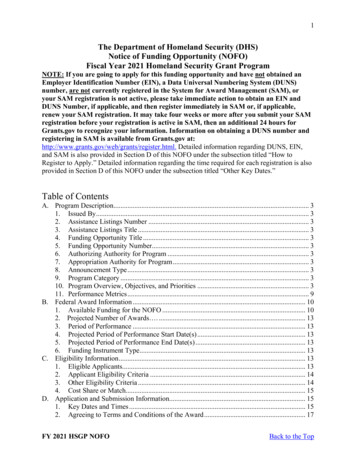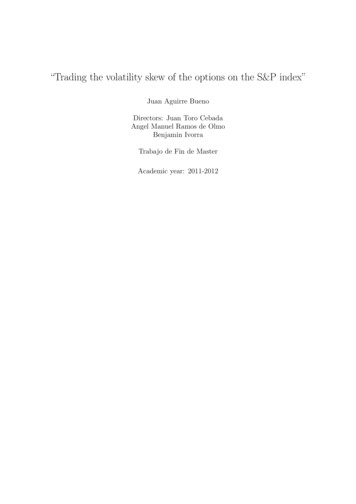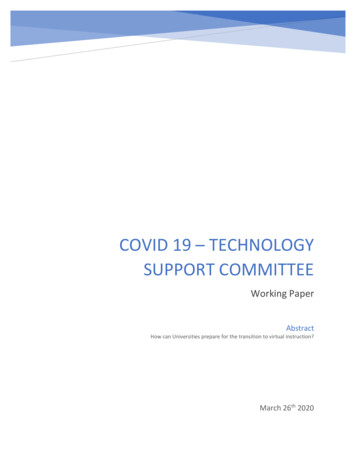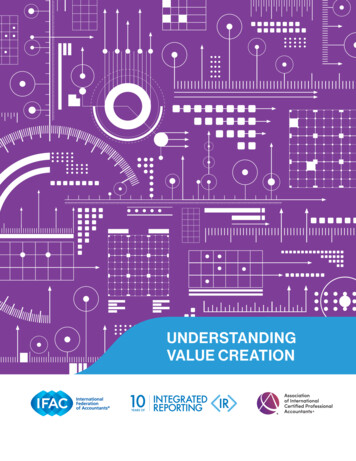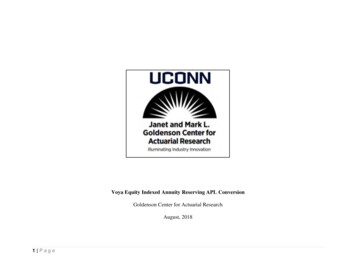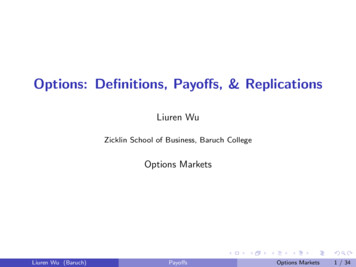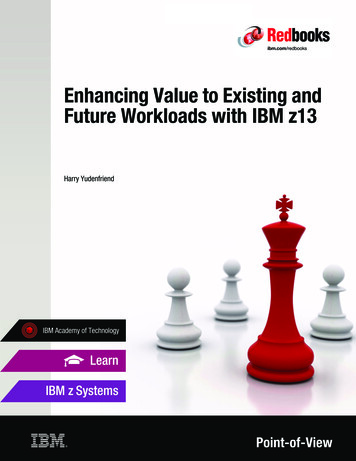
Transcription
Front coverEnhancing Value to Existing andFuture Workloads with IBM z13Harry YudenfriendIBM Academy of TechnologyLearnPoint-of-View
Enhancing Value to Existing andFuture Workloads with IBM z13An IBM Redbooks Point-of-View publicationfrom IBM SystemsThe business environment demandsresponses from technologyBy Harry Yudenfriend, IBM FellowHighlightsDiscover how to take advantage ofadvances in technology to address keydemands on today’s mainframes: Cloud computing, analytics, mobileaccess, social media, and security(CAMSS) put new demands onbusinesses and IT for enhancedresilience, performance, and scale. The volume of data and increased filesizes push networks to their limits andstress quality of service. A powerful, workload-optimized, open,agile, and highly secure IT infrastructureis required to meet customerexpectations.Technologies are rapidly changing the business environment.Cloud computing is increasingly seen as a growth engine forbusiness with new applications and capabilities. Theproliferation of mobile devices, social media access, massiveamounts of data, and the ever-looming threat of securitybreaches, make it imperative for organizations to adapt to meetthese demands. More and more organizations are relying onreal-time insight from structured and unstructured data to makeimportant decisions and to drive customer interactions. Having arobust IT infrastructure is essential in order for organizations tothrive in this new reality.A recommendation made by the IBM Institute of BusinessValue concerning these issues is that an IT infrastructure mustadapt to changing technologies and business requirements, andbe prepared to address numerous disruptions that can halt adigital enterprise.1These new dynamics are reframing the conversations on ITinfrastructure. In addition, C-level executives are acknowledgingthat a robust IT infrastructure is essential. The increasedreliance on data as a vital resource combined with theexpectations of today’s customers are forcing organizations tosearch out new and innovative ways to use hardware, software,networking, and storage.The IBM z Systems have many distinct advantages in thisdynamic business environment: z Systems are built on years of IBM leadership invirtualization and can host more virtual machines in a singlefootprint than any other platform. Its superior managementservices enables a mainframe’s resources to be sharedamong workloads, achieving the highest possible utilizationof the platform.2 z Systems are architected to operate with the highest levelsof reliability and availability. Each component is built to beresilient with support for nondisruptive configuration changesand dynamic replacement capabilities.12Redbooks Copyright IBM Corp. 2015.The IT infrastructure conversation, IBM Institute for Business Value, 2014,GBE03612-USEN-01, found as?htmlfid GBE03612USEN&appname skmwww#loadedComparing Virtualization Alternatives - What's best for your business?Solitaire Interglobal Report, 2012. found 03192usen/ZSL03192USEN.PDF1
z Systems have garnered some of the highestmarks for security in the industry.z Systems. These new QoS enhancements affectprocessing in the following ways: It has been found that a mainframe-based cloudimplementation can cost less, overall, than a cloudbuilt on other, competing platforms. Reduce transactional latency to mitigate increasesin transaction response times introduced by addingnew data sources and workloads.IBM z Systems I/O plays animportant role in supportingworkloadsNo matter where you start in your IT infrastructureanalysis, the ability to access, process, and move datato support your workloads is a key factor. IBM’sstrategy ensures that IBM mainframes provide the I/Ocapabilities necessary to handle the volume, velocity,processing power, and resilience needed for the newdemands on and for data. The ability to provideconsistent and secure interfaces and the ability to getthe right data to the right people are essential fortoday’s environment. The z Systems with its forwardthinking architecture is positioning itself to handle thesedemands now and in the future.The growth in cloud computing, analytics, mobileaccess, social media, and security (CAMSS) driveadditional requirements on z Systems. It must be ableto execute transactions with the same service levelagreements (SLA) and enterprise class qualities ofservice that the most demanding of z Systems clientshave come to expect. For example, adding new datasources from the cloud into a workflow might increaseelapsed times. Mobile access to data on z Systemsmight add an unpredictable increase in transactionvolume resulting in I/O contention. It is critical thatmiddleware (such as, IBM DB2 , IBM CICS , IBMMQ, and IBM IMS ) can scale to meet thesedemands. Lowering database transactional latency iscritical to mitigate the impact of new data sources andtransaction volumes on both the existing and newworkloads.The IBM z13 is built from the casters up for CAMSSworkloads. The I/O enhancements provides reducedtransactional latency, thus mitigating increases totransaction response times that might be introduced byadding cloud sourced data to the work flows. Theseperformance improvements also enhance thescalability of IBM z/OS and middleware, such as DB2,to meet the demands of mobile applications. Theincrease in the volume of I/O is driving the requirementfor further improvements to the already industryleading quality of service (QoS) capabilities of2 Improve resilience by enhancing the quality of theFibre Channel links to reduce error rates andincreasing performance to handle workload spikesand contention that might occur after hardwarefailures. Extend the z/OS workload manager into the storagearea network (SAN) fabric to manage theend-to-end work according to client specified policy.This capability includes all read and writeoperations and the synchronous replication activitygenerated by write operations using the IBMDS8870 Metro Mirror technology. Provide reduced cost for the physical infrastructurewith enhanced virtualization to allow sharing moreof the enterprise I/O traffic over shared inter switchlinks (ISLs). Provide improved availability with additionalflexibility and scale to the I/O configuration.z13 is the latest generation of the IBM mainframe todeliver substantial value to the I/O infrastructure: IBM Fibre Connection (FICON ) Dynamic Routingis a feature that enables use of SAN dynamicrouting polices in the fabric to lower costs byallowing clients to share FICON and Metro Mirror(FCP) on the same inter-switch links (ISLs). Thisfeature can reduce the cross site bandwidthrequirements and simplify configuration definitionsand performance management by providingpredictable and repeatable performance. Mainframe SAN Fabric Priority with the IBMDS8870, or other storage technologies, extends thez/OS Workload Manager (WLM) to the SANinfrastructure providing improved resilience andautonomic capabilities while enhancing the value ofFICON Dynamic Routing. Fabric priority issupported for FICON Express16S and FICONExpress8S channels on the IBM z13. FICON Express16S with the IBM DS8870 and16 Gbs host bus adapters, enables the IBM z13 toprovide up to 32% reduced I/O service times forDB2 log writes as compared to FICON Express8Son EC12.This difference can reduce DB2transactional latency by up to 19%. Additionally, I/Obound batch jobs can also reduce elapsed time byup to 32%, thus helping to relieve pressure on thebatch window.Enhancing Value to Existing and Future Workloads with IBM z13
FICON Express16S channels provide Forward ErrorCorrection (FEC) technology. The host busadapters (HBAs) enable the Fibre Channel linkprotocol to operate at higher speeds, over longerdistances, with reduced power and higherthroughput, while retaining the same reliability androbustness that FICON is traditionally known for. IBM High Performance FICON for z Systems(zHPF) Extended Distance II feature with the IBMDS8870 or other supporting storage, reduces theimpact of distance on zHPF I/O response times byup to 50% at 100KM for large write operations( 64K), providing significant response timeimprovements after a HyperSwap for multi-siteIBM Parallel Sysplex environments. FICONExpress16S and FICON Express8S support thezHPF Extended Distance II protocol to DS887016 Gbs capable ports. Scaling to six logical channel subsystems (LCSS)allows for up to 85 client usable LPARs. All z13 FICON channels (FICON Express8, FICONExpress8S, and FICON Express16S) support up to32K devices per channel, up from 24K on the EC12. A fourth subchannel set for each logical channelsubsystem (LCSS) is provided to eliminate singlepoints of failure for storage after a disk failure. Itfacilitates the exploitation of IBM DS8870Multi-target Metro Mirror storage replication withIBM Geographically Dispersed Parallel Sysplex (IBM GDPS ) and IBM TotalStorage ProductivityCenter for Replication (IBM TPC-R) HyperSwap.Improve quality of serviceIBM z Systems input/output (I/O) channels provide apipeline through which data is exchanged betweensystems or between a system and external devices.Fibre Connection (FICON) is an IBM I/O technology(used by z Systems) built on the Fibre Channelarchitecture.Reducing transactional latency mitigates increases totransaction response times introduced by addingworkloads. Also, performance improvements mightimprove the scalability of IBM z/OS and middleware,(such as, DB2) to meet the demands of mobileapplications and analytics. The increase in the volumeof I/O activity drives the requirement for furtherimprovements to the already industry leading quality ofservice capabilities of z Systems.control units, and storage devices. The FICONExpress16S channels allow faster and more efficientdata transfer while at the same time allowing you to usecurrently installed single mode and multimode fiberoptic cabling. FICON uses long wavelength (LX) andshort wavelength (SX) transceivers with multimode andsingle mode fiber optic media for data transmission.FICON Express16s channels reduce I/O latency. Thisfeature is valuable for reduced transactional latency fordatabases and shrinking the batch window for I/Obound batch work. IBM performance testing shows thatFICON Express16s and DS8870 16 Gbs FibreChannel ports improves I/O service times between byup to 32% as compared to FICON Express8S runningon the IBM EC12.3In support of the IBM z13 Mainframe, the IBM DS8870storage subsystem also adds enterprise class qualitiesof service to further provide value for z System clients.The IBM DS8870 has issued a statement of direction(SOD)4 for 2Q2015 for the support of 16 Gbs host busadapters to complement the FICON Express16Schannel. In addition, QoS features include ForwardError Correction codes for optical links to improvereliability, comprehensive SAN fabric priority controlledby the z/OS Workload Manager and propagated toreplication traffic to improve resilience and FICONDynamic Routing support to help clients reduce cost.Streamline I/O executionzHPF is an optional feature that streamlines z SystemsI/O execution for some I/O capabilities. Essentially,zHPF uses the hardware assists built into FibreChannel host bus adapters (HBAs) for the FCPprotocol, to transport z Systems I/O commands. At thesame time, zHPF preserves the z Systems traditionalqualities of service, such as: In-band I/O measurements End-to-end data integrity protection transparent toapplications and middleware Workload management Self-describing components for recognition of singlepoints of failureThe main value of zHPF is I/O performance. WithzHPF, fewer Fibre Channel sequences are needed toexecute an I/O operation. I/O latency is reduced and3The FICON channel matches data storage and accessrequirements with the latest technology in servers,4Fifty percent mix of reads and writes, 256K per I/O operationRelease memorandum - RFA 61029 - 01/14/15 (RFA Guide 29.08),section 2.7.7, FICON Express16S - a new generation for FICON,zHPF, and FCP.3
there is less contention at the channel, control unitports, and in the SAN fabric.zHPF supports multitrack operations. It allows thechannel to operate at rates that fully use the bandwidthof a FICON Express channel. The zHPF devicecommands fully support multiple tracks of data that canbe transferred in a single I/O operation.The zHPF Extended Distance II feature available withthe z13 and IBM DS8870 (2Q2015) improves the I/Oservice time for executing large write operations( 64 KB) at long distances. FICON and zHPF bothsupport 100 KM distances. The FCP transport used byzHPF typically requires an interlocked round tripbetween the channel and control unit for each 64KB tobe written. Enhancements to zHPF are provided tohelp eliminate the multiple interlocked round trips thusreducing the I/O service for large write operations at adistance. Long distance writes can occur, for example,after a Hyperswap event or in a multi-site workload withapplication systems running in both sitesBy addressing limits on the FICON channels,consolidating multiple storage subsystems on thesame set of channels (such as, a switch distributed startopology) is possible. This action increases the scale ofthe I/O configuration and facilitates the use of other I/Otechnologies by freeing I/O adapter slots. For example,zEDC, RoCEE Express and Flash Express all requireI/O adapter slots.Support for dynamic routing policies inthe SANWith z13, FICON channels are no longer restricted tothe use of static SAN routing policies for cascadingFICON directors. This enhancement is provided toreduce cost, improve performance, simplifymanagement, and position z Systems for futureinnovations is SAN technology. The z Systems featurethat supports dynamic routing in the SAN is calledFICON Dynamic Routing (FIDR). FIDR is designed tobe switch vendor agnostic. Clients need to determinewhich switch vendors support FIDR or only enableFIDR for switches that support FIDR. It is important tounderstand that dynamic routing policies must be usedonly with supporting switches and devices. z/OS healthchecks and HCD function are added to help clientsidentify devices that support FIDR and switches thatare running with FIDR enabled.The IBM z13 provides an architected means for thehost operating system software to specify an I/Opriority for the SAN fabric use. This capability allows4z/OS to extend the z/OS Workload Manager (WLM)5 tomanage the SAN fabric, thus completing themanagement of the entire end-to-end flow of an I/Ooperation.6 The z/OS operating system manages theflow by first querying the range of supported fabricpriorities from each SAN switch in the I/O configuration.From this information, z/OS derives a priority rangesupported for all the physical switches. WLM thenassigns I/O priorities consistent with the client specifiedgoals for the workloads within the supported range.With the Fabric I/O priority specified by WLM, the writeoperations are managed by the fabric. For readoperations, when the IBM DS8000 sends the data tothe host, the DS8870 uses the I/O priority specified byWLM on the original read I/O command. This prioritysetting enables the fabric to manage the return of thedata to the host according to the appropriate priority.As more and more I/O work shares a pool of ISLs,fabric priority is a critical capability for managingperformance toward the client goals. The IBM DS8870is also enhanced to propagate the fabric priority of thewrite operations that require replication services suchas, IBM Metro Mirror to the FCP-based generated I/Oactivity. This innovation provides a true end-to-endworkload management capability for z/OS trafficthrough the SAN infrastructure.As more and more I/O work shares a pool of ISLs,fabric priority is a critical capability for managingperformance toward the client goals. The IBM DS8870is also enhanced to propagate the fabric priority of thewrite operations that require replication services, suchas, IBM Metro Mirror to the PPRC FCP-basedgenerated I/O activity. This innovation provides a trueend-to-end workload management capability for z/OStraffic through the SAN infrastructure.Reduce I/O latency and improve I/OresiliencyThe primary value of moving to faster link technologiesis reduction of I/O latency for “large” read/writeoperations. The time for DB2 to write to the log canalso be quite substantial. A reduction in log writelatency improves DB2 transactional latency. As stated56Robert Vaupel, Managing Workloads in z/OS, IBM SystemsMagazine, January 2004, found /Harry M. Yudenfriend, IBM System z Innovations AutomaticallyDefine Configurations for Greater Availability, IBM SystemsMagazine, July 2013, found Data-Management/zdac yudenfriend/Enhancing Value to Existing and Future Workloads with IBM z13
previously, FICON Express16S with DS8870 16 Gbslinks can reduce I/O service times for the DB2 log writeup to 32%. For a well-tuned SAP banking workload,60% of the transactional latency is spent waiting forsynchronous I/O. This synchronous I/O is devoted towrites to the DB2 log. A 32% reduction applied to 60%of the latency yields a 19% improvement to thetransactional latency, a substantial improvement.It is important to understand two important facts aboutthe history of the z Systems FICON Express channelsand their growing capabilities in terms of increasing I/Orates and link bandwidth. First, the growth in I/O rateshas been mostly from High Performance FICON for zSystems (zHPF). Second, the growth in link bandwidthalso comes mostly with zHPF exploitation. Both ofthese trends will continue.The faster link speeds are more sensitive to the qualityof the cabling infrastructure. In the past, if the opticalfibers were abused (such as if they were subjected toexcessive bending and twisting, leaving the dust coversoff, or faulty connections at patch panels), clients mighthave seen an increase in I/O error rates aftertransitioning to a faster link speed (for example, 4 Gbsto 8 Gbs). IBM z Systems brings an Enterprise Class ofquality to the FICON Express16S channel to helpsmooth the transition to faster link speeds.With the FICON Express16s channel, IBM addedForward Error Correction (FEC) capabilities to theFibre Channel link protocol, using the most advancedFEC coding in the industry. FEC allows FICONchannels to operate at higher speeds, over longerdistances, with reduced power and higher throughput,while retaining the same reliability and robustness thatFICON has traditionally been known for.With FEC enabled, errors that might occur the fasterlink speeds will likely be corrected by the errorcorrection technology in the optical transmit/receiveports. Clients will experience fewer I/O errors, therebyeasing the transition to the new link technologies andreducing the potential impact to any productionworkloads by I/O errors. For optimal value, theend-to-end channel to control unit path needs to run at16 gigabit link speed for the optimal latency reduction.Likewise, each link, the entire path from the channelthrough the switch ports to the storage subsystem,should be protected by an FEC capable link tominimize the risk of I/O errors.z Systems provide two tools for testing the I/Oconfiguration: IBM System z I/O Exerciser simplifies the chore ofexercising the I/O connections in the I/Oconfiguration before bringing up z/OS and runningproduction work. It helps identify possible cabling ordefinition errors by validating that all the pathsdefined to each device actually connect to the samephysical device. Additionally, a data transfer stresstest is performed to help verify the quality of thecabling infrastructure. IBM z/OS I/O Exerciser runs as a started task underz/OS. It can be used to test individual device rangesin a controlled fashion. To obtain this tool, go to thisweb /preLogin.do?source swg-beta-ibmioexzosWhen errors are detected, how does the client identifythe root cause? In other words, which connection isfaulty? The new T11 Read Diagnostic ParametersExtended Link Service (RDP ELS) defines a methodfor some intelligence in the SAN fabric to retrievestandard counters that describe the optical signalstrength (send and receive), error counters, and othercritical information for determining the quality of thelink. SAN management tooling can be used to displaythe link information for every architected point in theconnection.In a future release of z/OS, after a link error is detected(for example, IFCC, CC3, reset event, or link incidentreport), link data returned from Read DiagnosticParameters is used to differentiate between errors dueto failures in the optics versus failures due to dirty orfaulty links. Additionally, z/OS health checks will bedelivered to detect when the end-to-end link speedsare inconsistent and if all paths to a control unit haveinconsistent link speeds. This capability simplifiesdiagnosing performance problems. Finally, z/OSoperator commands will allow clients to display thediagnostic parameters, which includes informationsuch as the optical signal strength, so that clients canpinpoint bad links without having to move around thefloor inserting light meters.5
What’s next: How IBM can helpIBM has a broad range of expertise to help youincorporate existing, new, and emerging workloads intoyour z Systems environment. IBM can help you withany z Systems issues you have around theseworkloads.The z Systems continue to make improvements thatsupport new and dynamic workloads. For moreinformation about z Systems, contact your local IBMrepresentative.Resources for more informationFor more information about the concepts highlighted inthe paper, see the following resources: Get More Out of Your IT Infrastructure With IBM z13I/O Enhancements, p5134.html?Open IBM System z Connectivity Handbook, 45444.html?Open IBM zEnterprise System Technical abstracts/sg248050.html?Open System z End-to-End Extended Distance ts/sg248047.html?Open Security on the IBM Mainframe: Volume 1 A HolisticApproach to Reduce Risk and Improve ieces/abstracts/sg247803.html?Open Understanding Mainframe Economics, p5127.html?Open IBM z Systems product pagehttp://www-03.ibm.com/systems/z/?lnk mprSY-sysz-usen IBM z Systems Academic n/academic/schools ap.html6Enhancing Value to Existing and Future Workloads with IBM z13
NoticesThis information was developed for products and services offered in the U.S.A.IBM may not offer the products, services, or features discussed in thisdocument in other countries. Consult your local IBM representative forinformation on the products and services currently available in your area. Anyreference to an IBM product, program, or service is not intended to state orimply that only that IBM product, program, or service may be used. Anyfunctionally equivalent product, program, or service that does not infringe anyIBM intellectual property right may be used instead. However, it is the user'sresponsibility to evaluate and verify the operation of any non-IBM product,program, or service.IBM may have patents or pending patent applications covering subject matterdescribed in this document. The furnishing of this document does not give youany license to these patents. You can send license inquiries, in writing, to:IBM Director of Licensing, IBM Corporation, North Castle Drive, Armonk, NY10504-1785 U.S.A.The following paragraph does not apply to the United Kingdom or anyother country where such provisions are inconsistent with local law:INTERNATIONAL BUSINESS MACHINES CORPORATION PROVIDES THISPUBLICATION "AS IS" WITHOUT WARRANTY OF ANY KIND, EITHEREXPRESS OR IMPLIED, INCLUDING, BUT NOT LIMITED TO, THE IMPLIEDWARRANTIES OF NON-INFRINGEMENT, MERCHANTABILITY OR FITNESSFOR A PARTICULAR PURPOSE. Some states do not allow disclaimer ofexpress or implied warranties in certain transactions, therefore, this statementmay not apply to you.This information could include technical inaccuracies or typographical errors.Changes are periodically made to the information herein; these changes will beincorporated in new editions of the publication. IBM may make improvementsand/or changes in the product(s) and/or the program(s) described in thispublication at any time without notice.Any references in this information to non-IBM Web sites are provided forconvenience only and do not in any manner serve as an endorsement of thoseWeb sites. The materials at those Web sites are not part of the materials forthis IBM product and use of those Web sites is at your own risk. TrademarksIBM, the IBM logo, and ibm.com are trademarksor registered trademarks of International Business Machines Corporation in the UnitedStates, other countries, or both. These andother IBM trademarked terms are marked ontheir first occurrence in this information with the appropriate symbol ( or ),indicating US registered or common law trademarks owned by IBM at the timethis information was published. Such trademarks may also be registered orcommon law trademarks in other countries. A current list of IBM trademarks isavailable on the Web at e following terms are trademarks of the International Business MachinesCorporation in the United States, other countries, or both:CICS DB2 DS8000 FICON GDPS Geographically Dispersed Parallel Sysplex HyperSwap IBM IMS Parallel Sysplex Redbooks Redbooks (logo)System z z/OS The following terms are trademarks of other companies:Other company, product, or service names may be trademarks or servicemarks of others.IBM may use or distribute any of the information you supply in any way itbelieves appropriate without incurring any obligation to you.Information concerning non-IBM products was obtained from the suppliers ofthose products, their published announcements or other publicly availablesources. IBM has not tested those products and cannot confirm the accuracy ofperformance, compatibility or any other claims related to non-IBM products.Questions on the capabilities of non-IBM products should be addressed to thesuppliers of those products.This information contains examples of data and reports used in daily businessoperations. To illustrate them as completely as possible, the examples includethe names of individuals, companies, brands, and products. All of these namesare fictitious and any similarity to the names and addresses used by an actualbusiness enterprise is entirely coincidental.Any performance data contained herein was determined in a controlledenvironment. Therefore, the results obtained in other operating environmentsmay vary significantly. Some measurements may have been made ondevelopment-level systems and there is no guarantee that thesemeasurements will be the same on generally available systems. Furthermore,some measurements may have been estimated through extrapolation. Actualresults may vary. Users of this document should verify the applicable data fortheir specific environment.COPYRIGHT LICENSE:This information contains sample application programs in source language,which illustrate programming techniques on various operating platforms. Youmay copy, modify, and distribute these sample programs in any form withoutpayment to IBM, for the purposes of developing, using, marketing ordistributing application programs conforming to the application programminginterface for the operating platform for which the sample programs are written.These examples have not been thoroughly tested under all conditions. IBM,therefore, cannot guarantee or imply reliability, serviceability, or function ofthese programs.Note: The IBM statements regarding its plans, directions, and intent aresubject to change or withdrawal without notice at IBM's sole discretion.Information regarding potential future products is intended to outline ourgeneral product direction and it should not be relied on in making a purchasingdecision. The information mentioned regarding potential future products is nota commitment, promise, or legal obligation to deliver any material, code, orfunctionality. Information about potential future products may not beincorporated into any contract. The development, release, and timing of anyfuture features or functionality described for our products remain at our solediscretion.This document, REDP-5135-00, was created or updated on February 5, 2015. Copyright IBM Corp. 2015.7
on the IBM EC12.3 In support of the IBM z13 Mainframe, the IBM DS8870 storage subsystem also adds enterprise class qualities of service to further provide value for z System clients. The IBM DS8870 has issued a statement of direction (SOD)4 for 2Q2015 for the support of 16 Gbs host bus adapters to complement the FICON Express16S channel.

